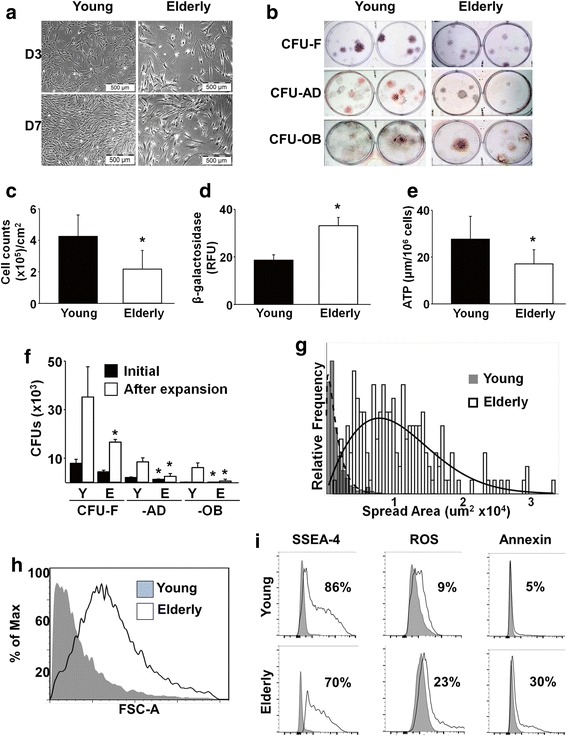Fig. 1.

Compared to young MSCs, elderly MSC quantity and quality is reduced. a, c Brightfield microscopy of MSCs cultured on TCP for 3 or 7 days shows that elderly MSCs were less confluent than young MSCs. By day 7, density of elderly MSCs was significantly lower (n = 16 donors (11 elderly, five young) tested in replicate experiments). b, f After 7 days in culture on TCP, the frequency of young (Y) and elderly (E) MSCs was assessed using CFU-F, CFU-AD, and CFU-OB assays. Cells from elderly donors displayed markedly less CFU replication and differentiation capability (n = 10 donors (five elderly, five young) tested in replicate experiments). d, e β-galactosidase and ATP were measured and elderly MSCs were found to have significantly higher levels of β-galactosidase and significantly lower levels of ATP than young MSCs (n = 10 donors (five elderly, five young) tested in replicate experiments). g, h Cell spread area and cell size (using forward scatter (FSC-A) in flow cytometry) were measured after 3 days in culture. Elderly MSCs cultured on TCP were larger and displayed a wider range of mean cell spread area than young MSCs. i Markers of stemness (SSEA-4) and aging (intracellular ROS and Annexin V) were measured using flow cytometry. Elderly MSCs cultured for 7 days on TCP contained a smaller fraction of cells positive for SSEA-4 and a larger fraction of cells positive for early markers of apoptosis (ROS and Annexin V) than young MSCs (n = 10 donors (five elderly, five young) tested in replicate experiments). *P < 0.05, vs young MSCs. D day, CFU colony forming unit, F fibroblast, AD adipocyte, OB osteoblast, ATP adenosine triphosphate, ROS reactive oxygen species, SSEA-4 stage-specific embryonic antigen-4
